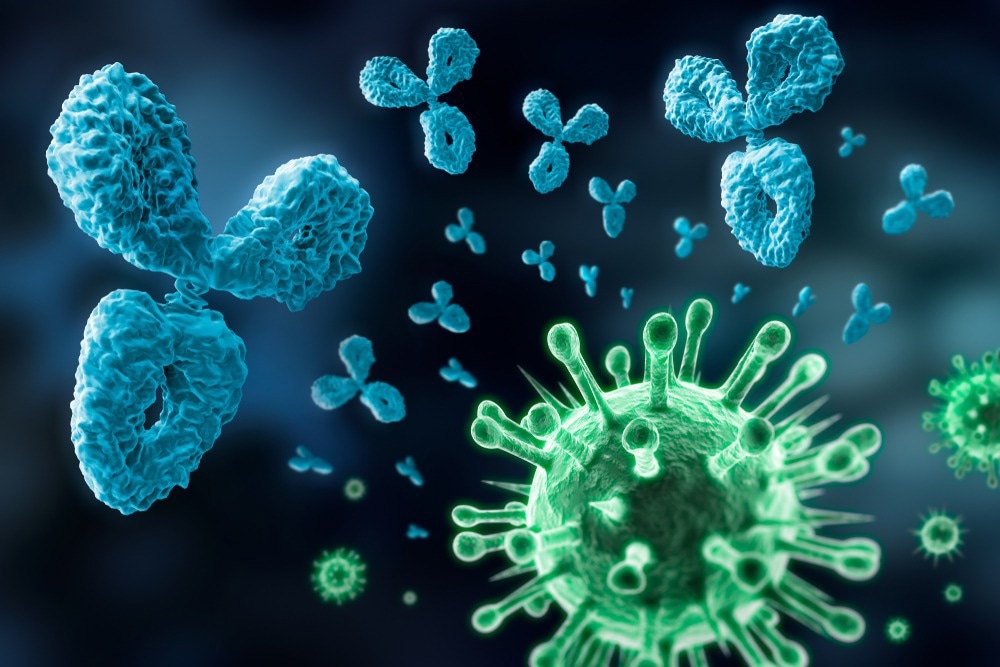In a recent study posted to the bioRxiv* preprint server, researchers assessed the effectiveness of pan-sarbecovirus-neutralizing antibodies against severe acute respiratory syndrome coronavirus 2 (SARS-CoV-2).

Background
Within the past two decades, the zoonotic spread of coronaviruses has produced three pandemics of serious respiratory illnesses. Despite the rapid development of coronavirus disease 2019 (COVID-19) vaccines and antibodies, several SARS-CoV-2 variants of concern (VOCs) have evolved.
Recent investigations have shown that the efficacy of the BNT162b2 vaccination during the SARS-CoV-2 Omicron BA.4/5 infection waves was less than 50% post-two or three doses, while a fourth dose elicited only a minor, temporary increase in Omicron-neutralizing antibody levels. In addition, therapeutic antibodies currently available have diminished effectiveness against Omicron variants, highlighting the need for broad protective vaccinations and monoclonal antibodies.
About the study
In the present study, researchers detected strong pan-sarbecovirus antibodies among non-human primates vaccinated against SARS-CoV-2 with a subunit vaccine adjuvanted with AS03.
The team investigated the antigen-specific memory B cell responses of peripheral blood mononuclear cells (PBMC) samples obtained from rhesus macaques vaccinated with receptor-binding domain (RBD)-nucleoprotein (NP) adjuvanted with AS03, Alum, AS37, CpG, or O/W. The circulating SARS-CoV-2 RBD-specific immunoglobulin (Ig)G+ memory B cells (MBCs) were estimated using fluorescently-labeled probes and flow cytometry.
Additionally, the team assessed MBC responses by utilizing PBMC samples obtained from macaques vaccinated with a two-dose primary vaccine of either AS03-adjuvanted RBD-NP or Hexapro-NP at days zero and 21, after which a booster AS03 adjuvanted RBD (beta)-NP vaccine was administered one year later. Furthermore, the antibody response and the MBCs in the blood of the RBD-NP-AS03- or Hexapro-NP-AS03-vaccinated were assessed over 1.5 years.
The top 206 SARS-CoV-2 Omicron BA.1-binding monoclonal antibodies (mAbs) were then selected for neutralization screening compared to the pseudotyped SARS-CoV-2 Wuhan strain and the BA.1 and BA.4/5 sublineages. The team also evaluated the neutralization activities as a function of time after vaccination to see if antibody maturation with respect to cross-reactivity or binding translated into increased neutralizing breath or potency.
Results
Antibodies eBook

The team noted that the somatic hypermutation (SHM) of the variable (V) gene, MBC frequency, and CDR3 amino-acid length were similar between the differentially adjuvanted cohorts, indicating that vaccination using distinct adjuvants induced a comparable pattern with respect to antigen-specific memory B cell responses. The booster vaccination elicited robust and broadly neutralizing antibodies against SARS-CoV-2 Omicron VOCs. Intriguingly, these Omicron-neutralizing antibodies were not observed five to six months after the primary vaccination.
After vaccination, the prevalence of antigen-specific IgG+ MBCs was the highest at 1.4 months before declining over the subsequent five to six months. Hexapro-NP vaccination induced high levels of IgG+ MBCs directed against the non-RBD area of the spike protein; however, there was no considerable difference among the RBD-specific IgG+ MBCs of Hexapro-NP and RBD-NP. Furthermore, SHM frequency increased from 1.4 months to five to six months before reaching a plateau at 12 months. Notably, the booster vaccination did not promote SHM further.
The vaccine comprising the Wuhan strain showed that the mean potency of neutralizing antibodies against the BA.1 and BA.4/5 lineages was remarkably lower than the Wuhan strain. Over 1.5 years, the frequency observed for SARS-CoV-2 Wuhan strain and BA.1 and BA.4/5 sublineages triple-neutralizing antibodies increased significantly, while the proportion of non-neutralizing antibodies decreased, indicating a development in neutralization breadth and potency.
Upon further examination of the consequences of this evolution, the team discovered that booster immunization considerably increased the average neutralization potency detected against the SARS-CoV-2 Wuhan strain and BA.1 sublineage. The researchers also noted an increase in the neutralizing breadth and potency of monoclonal antibodies within the memory B cell compartment.
The three most potent Omicron neutralizers, namely, 27A12, 27E3, and 21B6, competed against S2M11, the ultrapotent monoclonal antibody, which detects RBM-overlapping epitopes. Co-incubating the top four antibodies having the highest neutralization breadth, including 15F1, 25F9, 27E4, and 20A7, along with a SARS-CoV neutralizing antibody, like CR3022, or a pan-arbovirus neutralizing antibody, like S2X259, resulted in intense competition. This indicated that their binding epitopes are comparable.
Furthermore, 25F9 targeted a conserved area of the RBD wherein 23 to 27 of the total 28 epitope residues, which further explained the strong neutralizing efficacy of 25F9 against a wide spectrum of SARS-like viruses. Additionally, 20A7 showed effectiveness against all SARS-CoV-2 variants and SARS-CoV.
Conclusion
Overall, the study results highlighted the prophylactic protective efficacy of the most strong and broadly neutralizing antibodies, namely 20A7, 25F9, and 27A12, against four distinct SARS-related viruses. The researchers believe that the present study has provided 25F9 and 20A7 as two neutralizing antibodies having the highest neutralization potency, making them attractive prospects for treating sarbecovirus infection.
*Important notice
bioRxiv publishes preliminary scientific reports that are not peer-reviewed and, therefore, should not be regarded as conclusive, guide clinical practice/health-related behavior, or treated as established information.
- Feng, Y. et al. (2023) "Extremely potent pan-sarbecovirus neutralizing antibodies generated by immunization of macaques with an AS03-adjuvanted monovalent subunit vaccine against SARS-CoV-2". bioRxiv. doi: 10.1101/2023.01.19.524784. https://www.biorxiv.org/content/10.1101/2023.01.19.524784v1
Posted in: Medical Science News | Medical Research News | Disease/Infection News
Tags: Antibodies, Antibody, Antigen, Arbovirus, B Cell, Blood, Cell, Coronavirus, Coronavirus Disease COVID-19, covid-19, CpG, Cytometry, Efficacy, Evolution, Flow Cytometry, Frequency, Gene, Immunization, Immunoglobulin, Monoclonal Antibody, Omicron, Protein, Receptor, Respiratory, SARS, SARS-CoV-2, Severe Acute Respiratory, Severe Acute Respiratory Syndrome, Spike Protein, Syndrome, Vaccine

Written by
Bhavana Kunkalikar
Bhavana Kunkalikar is a medical writer based in Goa, India. Her academic background is in Pharmaceutical sciences and she holds a Bachelor's degree in Pharmacy. Her educational background allowed her to foster an interest in anatomical and physiological sciences. Her college project work based on ‘The manifestations and causes of sickle cell anemia’ formed the stepping stone to a life-long fascination with human pathophysiology.
Source: Read Full Article
